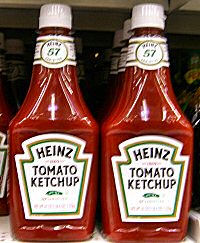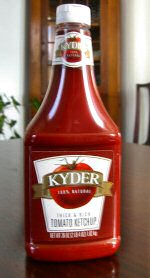
Hunt's and Del Monte ketchups in a retail display.
The word ketchup comes from the Chinese word “kôe-chiap” or “ke-tsiap,” meaning “brine of pickled fish or shellfish.” The original Chinese type of ketchup tasted more like soy or Worcestershire sauce, and did, of course, contain fish brine, plus herbs and spices. There were no tomatoes involved. The early recipe “traveled,” as good recipes do, to Malaysia and Indonesia. 17th century English sailors encountered the sauce in their journeys, and took the sauce and recipe concept home to England. (Another theory states that British explorers first discovered the condiment in Southeast Asia.) At any rate, instructions for making ketchups then spread to other parts of the Western world. The sauce was first mentioned in print in the English language in 1690. In 1748 in the Housekeeper's Pocketbook, Mrs. Harrison recommended that the homemaker never be without it.

Heinz has significant brand recognition.
The Chinese-type fishy ketchup evolved into various ketchup-type sauces: mushroom ketchup; walnut ketchup; eventually the tomato-style (more like what we eat now); and other different types. The older recipes usually call the sauce “catsup.” “Catchup” is yet another possible spelling.
In 1841 Sarah Josepha Hale, an American cookbook writer, offered recipes for walnut and tomato catsups, but she cast a disapproving eye at homemade mushroom catsup:
“Mushroom is most esteemed; but the difficulty in our country of obtaining the right kind of plant, (some are poisonous,) renders a receipt of little consequence. It is better to buy this catsup at the shops.”1
However, other cookbook writers were braver. In 1871 Marion Harland presented her instructions for making mushroom catsup. (She was by no means the first American to try her hand at this recipe.) Incidentally, I do not recommend actually preparing this dish. The long “setting aside” periods sound to me like great times for rapid bacteria growth. (How cool is cool?) Nevertheless, it is an interesting recipe:
Mushroom Catsup.
- 2 quarts of mushrooms.
- 1/4 lb. of salt.
Lay in an earthenware pan, in alternate layers of mushrooms and salt; let them lie six hours, then break into bits. Set in a cool place, three days, stirring thoroughly every morning. Measure the juice when you have strained it, and to every quart allow half an ounce of allspice, the same quantity of ginger, half a teaspoonful of powdered mace, a teaspoonful of cayenne. Put into a stone jar, cover closely, set in a saucepan of boiling water over the fire, and boil five hours hard. Take it off, empty into a porcelain kettle, and boil slowly half an hour longer. Let it stand all night in a cool place, until settled and clear. Pour off carefully from the sediment, and bottle, filling the flasks to the mouth. Dip the corks in melted rosin, and tie up with bladders.
The bottles should be very small, as it soon spoils when exposed to the air.2
Instructions for making walnut ketchup seem especially daunting:
Walnut Catsup.
Thoroughly bruise one hundred and twenty young walnuts; put to them three quarters of a pound of fine salt and a quart of vinegar; stir them every day for a fortnight; then strain; squeeze the liquor from them through a cloth; add to this one ounce of whole black pepper, forty cloves, half an ounce of nutmeg bruised; half an ounce of ginger, and a few blades of mace. Boil the whole for half an hour; strain and bottle it for use.3
Here's another:
Walnut Catsup.
Choose young walnuts tender enough to be pierced with a pin or needle. Prick them in several places, and lay in a jar with a handful of salt to every twenty-five, and water enough to cover them. Break them with a billet of wood or wooden beetle, and let them lie in the pickle a fortnight, stirring twice a day. Drain off the liquor into a saucepan, and cover the shells with boiling vinegar to extract what juice remains in them. Crush to a pulp and strain through a cullender [collander] into the saucepan. Allow for every quart an ounce of black pepper and one of ginger, half an ounce of cloves and half an ounce of nutmeg, beaten fine. Put in a pinch of cayenne, a shallot minced fine for every two quarts, and a thimbleful of celery-seed tied in a bag for the same quantity. Boil all together for an hour, if there be a gallon of the mixture. Bottle when cold, putting an equal quantity of the spice in each flask. Butternuts make delightful catsup.4
In 1879, Marion Cabell Tyree presented the following recipe for red pepper catsup:
Red Pepper Catsup.
To four dozen fine ripe bell-peppers add two quarts good vinegar, one quart water, three tablespoonfuls grated horseradish, five onions chopped fine. Boil till soft, and rub through a sieve. Then season to your taste with salt, spice, black and white mustard well beaten; after which boil ten minutes. Add celery-seed if liked, and a pod or more strong pepper, a little sugar. All should be cut up and the seed boiled with it. Bottle and cork tightly. — Mrs. G. N.5
Other off-beat types include Cucumber Catsup and Grape Catsup:
Cucumber Catsup.
Grate large cucumbers before they begin to turn yellow; drain out the juice, and put the pulp through a sieve to remove the large seeds; fill a bottle half full of the pulp, discarding the juice, and add the same quantity of ten per cent vinegar; cork tightly; when used, add pepper and salt; salt kills the vinegar if put in when made. This is almost like fresh-sliced cucumber when opened for use.6
Grape Catsup.
Ten lbs. fruit, 5 lbs. sugar, 1 qt. vinegar, two tablespoonsful each of black pepper, allspice and cinnamon ground.7

Kyder is a store-brand ketchup from Aldi Foods.
In 1908 Lilly Haxworth Wallace gave a recipe for tomato catsup. It is quite different from today's commercial sweet tomato catsup. This 1908 version contains green peppers and allspice. — My husband's mother and his older sister both made very sweet, spicy, chunky tomato catsup. It was more like salsa with sweet spices.
Modern store-bought bottle catsups are obviously less fuss than do-it-yourself. Heinz and Hunt's are two names which immediately come to mind. (F. & J. Heinz Company started selling tomato ketchup in 1876.) Store brands are also available.
One more thought about ketchup. — When our firstborn Sarah was learning to eat solids, we all went on a fairly long road trip. The only foods which Sarah would eat at that time were canned peaches (but most eateries did not have canned peaches on the menu); white commercial bread; and ketchup. Therefore, Sarah sat in many a restaurant, refusing to swallow anything other than white bread and ketchup. — I'm glad she was still nursing.
Copyright © 2006 Patricia B. Mitchell.